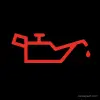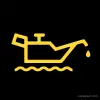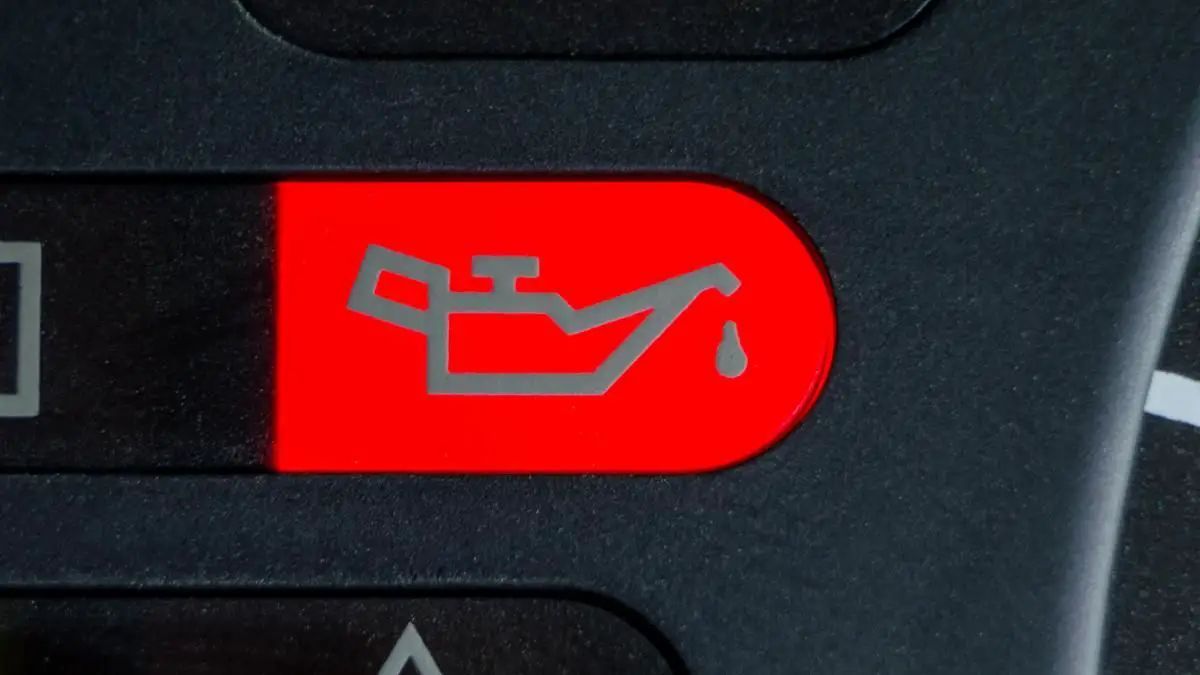One of those dashboard lights you don’t want to ignore is the oil warning light.
So if it comes on when you hit those brakes or take sharp corners, it’s easy to assume your car is trying to give you a heart attack. That’s not necessarily the case, but your car is definitely trying to tell you something that requires your attention.
In this article, we’ll cover the potential reasons why your oil light comes on when braking, and what you need to do to properly address the issue. So without further ado, let’s dive in!
What Does the Oil Warning Light Means?
The oil warning light is a red small indicator on your car’s dashboard that illuminates when there is a problem with the oil system. If the light comes on, it means that your engine is not receiving enough oil pressure, which can lead to inadequate lubrication.
Depending on your vehicle’s make and model, and the severity, the warning lights may appear in different colors – Red or yellow.


Typically, the red light means there’s a risk that damage is happening to your engine’s moving parts and requires immediate action. While yellow specifically indicates that your oil level is getting low, but yet not too low.
But not all manufacturers choose to include a yellow warning light. Some may rely solely on the red oil warning light to indicate both low oil levels and low oil pressure.
Normally, braking should not have any direct impact on either, but there are times when it could trigger the light. Let’s take a look.
Common Reasons Your Oil Light Comes On When Braking
The most common cause of the oil light coming on during braking is a drop in oil pressure, usually due to low oil levels. This is because braking can cause a temporary weight shift to the front of the vehicle, which can affect oil distribution in the engine and cause the light to come on.
While low oil level is the likely cause, it’s not the only one. So let’s lets take a closer look at a more detailed list.
1. Low Oil Level
When you brake or take a sharp turn and the oil is just on the verge of being too low, the oil in your engine can slosh around and move away from the oil pickup tube, which can cause a temporary drop in oil pressure. Enough to trigger the oil warning light.
A red oil warning light caused by a low oil level is a serious concern, even if it only illuminates when braking. It means that momentarily there may not be enough oil to properly lubricate and protect your engine.
2. Worn-out Oil Pump
Next up is the oil pump, often referred to as the engine’s heart. This critical device is responsible for circulating the engine oil and maintaining the required oil pressure throughout the engine.
If the oil pump is failing or not functioning correctly, it may not generate enough pressure to keep the oil warning light from coming on when the brakes are applied.
Other symptoms of a bad oil pump are increased engine temperature, noise from the valve train, or noise from the oil pump itself.
3. Wrong Oil Viscosity
Using oil that is too thin or has a lower viscosity than recommended for your vehicle can potentially cause the oil light to come on when braking.
Oil viscosity refers to its thickness and resistance to flow at a given temperature. Using oil with a lower viscosity than required can lead to reduced oil pressure.
One thing that can cause the oil to thin is if gasoline finds its way in and mixes with the oil. Now, this is rare, but it’s possible if you’re dealing with underlying issues, such as bad piston rings, faulty injectors, or a damaged carburetor (older vehicles).
4. Faulty Oil Pressure Sensor or Wiring
The oil pressure sensor is responsible for monitoring the oil pressure in the engine. when the oil pressure drops below a safe level, the oil pressure sensor sends a signal to the Engine Control Unit (ECU), and the information is displayed on the gauge.
Just like any other part of your vehicle, this sensor can also fail. If it does, it can falsely interpret the pressure, causing it to trigger the oil light erroneously. However, it could also be wiring issues causing a bad connection.
List of Other Potential Causes
- Clogged Oil Pickup Tube
- Clogged Oil filter
- Faulty Instrument Cluster
- Internal Oil Leak
- Clogged oil passages
- Wear of engine parts
How to Resolve Oil Light Coming On When Braking
If you’re ready to take the matter into your own hands, the best way to tackle the problem is the same way a professional technician would do. Here’s how:
Step 1: Check Oil Level
The first step is to check the oil level in your vehicle’s engine. Locate the oil dipstick, usually marked with a bright handle, and pull it out. Wipe it clean with a cloth or paper towel and reinsert it fully.
Now, pull it out again and examine the oil level. It should fall between the “full” and “low” marks on the dipstick. If the oil level is below the recommended range, you’ll need to add more oil.
If you find that your engine’s oil level is consistently dropping even after adding oil, there might be an oil leak.
To identify the source of the leak, inspect the engine system carefully. Look for any signs of dripping oil around the oil pan, seals, or gaskets. Identifying the location of the leak will help you decide whether you can fix it yourself or if it requires professional attention.
Step 2: Perform an Oil and Filter Change:
If the oil level is fine, but the oil appears dirty or contaminated, it’s time for an oil change. Regular oil and filter changes are crucial for maintaining engine health. Refer to your vehicle’s service manual for the recommended oil change interval (usually between 5,000 to 10,000 miles) based on the type of oil you use.
Depending on how often you tow, drive in tough terrains, or use your vehicle harshly, you may need more frequent oil changes. Using fresh oil guarantees the best engine protection and performance.
Step 3: Inspect the Oil Pump
If suspicions persist about the oil pump’s condition, you may need to inspect it closely. Removing the pump cover will allow you to check for signs of wear, such as heavy scoring or the presence of metal particles in the pump body.
If wear is evident, it’s best to replace the oil pump with a new one. However, if it appears to be in good condition, cleaning it thoroughly and reinstalling it may suffice.
Note that accessing the oil pump, often located inside the oil pan, can be challenging, so ensure you’ve explored all other possibilities before proceeding with this step.
Step 4: Seek Professional Assistance
Dealing with low oil pressure can be complex and may require professional expertise. If you’re unsure about any step or unable to resolve the issue on your own, it’s wise to reach out to a trusted and qualified mechanic.
Before choosing a professional, read online reviews and ensure they have the necessary knowledge and experience to handle engine-related problems.
How Much Does It Cost to Fix A Flickering Oil Light?
It’s hard to say how much you’ll end up paying to get a flickering oil light fixed. It all comes down to what the issue is. But if it’s simply due to a low engine oil level, you may only need an oil change or topping it off. Replacing an oil pressure sensor is also considered inexpensive.
However, when it comes to replacing an oil pump, you can expect to pay significantly more. And if there’s underlying oil leakage, it can range from a few tens of dollars to thousands.
Below are cost estimates to give you a fair picture. These estimates count for both part and labor costs. Keep in mind that these can vary depending on various factors, such as the make and model of your vehicle.
- Oil change + filter: $30-$150
- Replacing worn-out oil pump: $300-$800
- Replacing a faulty oil pressure sensor: $100-$130
Is It Safe To Drive With Oil Light Flickering?
No, it is not safe to drive with the oil light flickering. Even if the light only comes on every now and then, it means the oil pressure is low on these occasions and could potentially damage the engine. If necessary, drive with extreme caution and address the issue as soon as possible.
FAQs
How long can you drive on low oil pressure?
How long you can drive with low oil pressure before engine damage occurs can vary widely depending on several factors, such as the severity of the oil pressure drop and driving conditions. In some cases, engine damage may happen within seconds or minutes if the oil pressure is critically low.
Can I continue driving if the oil light comes on during braking?
While it’s best to avoid driving with the oil light on, if it flickers briefly during braking and goes off, it might be a minor glitch. However, continuous or frequent illumination requires immediate attention as it indicates low oil pressure that could severely damage the engine.
Why does the oil light come on when I go around corners?
The oil light may come on while turning corners due to low oil levels in your car. As you turn, the oil in the oil pan shifts away from the oil pickup tube. If the oil level is critically low, the oil pickup tube may become completely removed from the oil, resulting in a lack of oil pressure, triggering the warning light.
Conclusion
In conclusion, if your oil light comes on when braking, don’t dismiss it as a minor issue. It could indicate low oil pressure due to reasons like low oil level, a worn-out oil pump, or using the wrong oil. Ignoring it could lead to severe engine damage.
If you’re not sure how to fix this issue yourself, it’s recommended to have a qualified mechanic check it promptly to ensure your car’s safety and longevity. Regular maintenance and attention to warning signs are crucial for a smoother and safer driving experience – not least to avoid expensive costs.
That’s all for this article. Thanks for reading and if you found it helpful, kindly share it with others. See you around!

